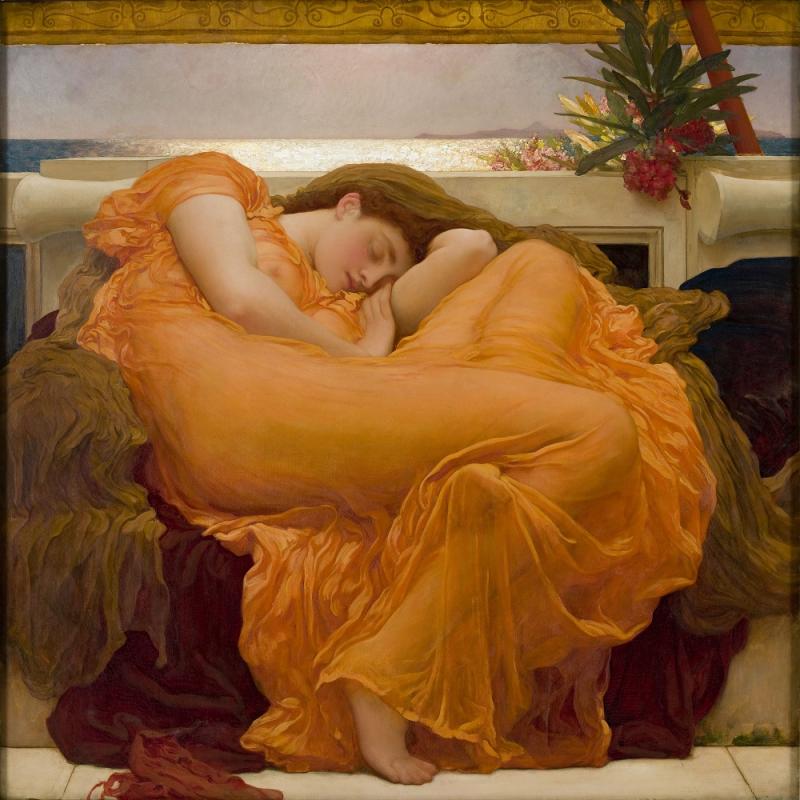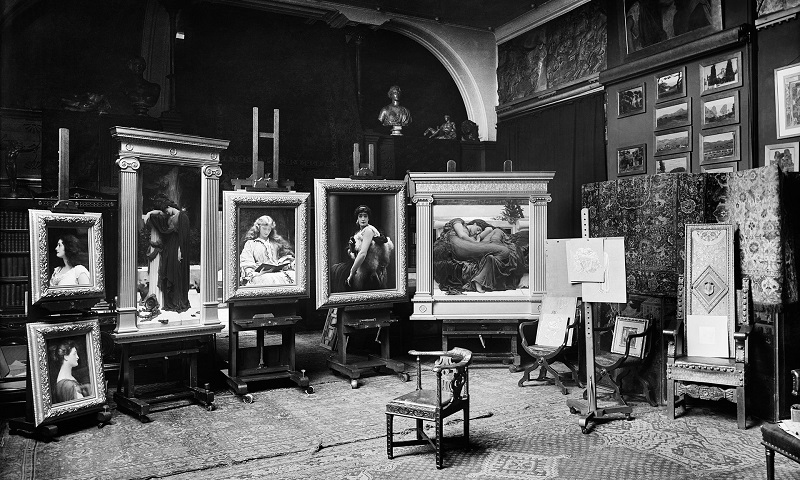Flaming June, Leighton House Museum | reviews, news & interviews
Flaming June, Leighton House Museum
Flaming June, Leighton House Museum
Reunited with the artist's final works, a painting rarely seen but endlessly reproduced

The chances are, you’ve only ever seen Flaming June in reproduction: since 1963 it has resided in the Museo de Arte de Ponce in Puerto Rico, an out-of-the-way location that reflects the universal disdain for Victorian art in the post-war period.
Returned to the studio at Leighton’s fabulous "House Beautiful" for the first time since 1895 and reunited with the group of paintings submitted by him to the Summer Exhibition of that year, the reasons for Flaming June’s reputation as an appalling example of Victorian bad taste are immediately apparent. Ubiquitous it might be, but no reproduction can prepare you for the visual assault of that orange dress, and despite its erstwhile reputation as typically tasteless Victoriana, it is worth noting that even in the 19th century, it got a mixed reception.
The critics fell over themselves trying to describe the sickly hue that dominates the painting, and whether they called it "old gold", "light amber pink" or "topaz yellow", all were agreed that this was a colour only Leighton could have produced. Looking at it now, surrounded by the more conventionally subdued palettes of its companion pieces, Leighton’s orange is bizarrely anachronistic, belonging more to the age of plastics and petrochemicals than coal and steam.
 If that’s not an entirely positive assessment of Flaming June’s modernist credentials, a real-life encounter with this painting permits a surprising, and far more compelling revelation: it’s a colour field painting. While colours have always been used to achieve a balanced composition, a small oil sketch on display nearby shows the extent to which Leighton designed his canvas as an abstract arrangement of blocks of colour, dominated by a hot orange centre.
If that’s not an entirely positive assessment of Flaming June’s modernist credentials, a real-life encounter with this painting permits a surprising, and far more compelling revelation: it’s a colour field painting. While colours have always been used to achieve a balanced composition, a small oil sketch on display nearby shows the extent to which Leighton designed his canvas as an abstract arrangement of blocks of colour, dominated by a hot orange centre.
Of course much of this painting’s fascination lies in its ambiguity, the title and broadly classicising appearance of the figure and setting suggesting the personification of summer, but more convincingly, the post-coital slumber of a woman aflame with desire. So is it just a sexy picture dressed up as something more edifying? It’s tempting to think so, although its many allusions to the art of the past and contemporary culture do more than simply provide a cloak of respectability for porn.
The knowledge that times were changing seems woven into this final group of paintingsThe sleeping woman is an ancient iconographic trope, common in the Renaissance and popular in the 19th century, when for Victorian audiences, sleep had a particular association with drug-induced intoxication and death. And that curled-up pose is as old as art itself, with endless precedents in Greek sculpture, resurfacing in Michelangelo’s figure of Night, c.1521-34, made to form part of the decorative scheme for the Medici tombs at San Lorenzo, Florence, photographs of which Leighton kept in his studio. Michelangelo reused this figure in a painting of Leda and the Swan, 1529, an image so erotic that it was burned in the 17th century by the Spanish Queen Mother.
As one of a group of paintings of lone female figures, immortalised in a photograph of Leighton’s studio shortly before the 1895 Summer Exhibition (pictured above), Flaming June is the most frankly erotic, and perhaps this adds to the picture's strange modernity. And yet, even as it went on show just months before Leighton’s death in 1896, times were changing, the knowledge of which seems woven into this final group of paintings. In amongst the idealised, sentimental images of otherworldly women was The Maid with the Golden Hair, a woman idealised for sure, but presented in what was identified at the time as a specifically English, rather than classical style, the informal pose indicative of a growing interest in the depiction of everyday life. In this painting, seen in the emphatically Victorian surroundings of Leighton’s residence, the artist seems less a relic from the distant past, and more an artist on the cusp of a new age.
- Flaming June: The Making of an Icon at Leighton House Museum until 2 April 2017
- Read more visual arts reviews on theartsdesk
rating
Share this article
The future of Arts Journalism
You can stop theartsdesk.com closing!
We urgently need financing to survive. Our fundraising drive has thus far raised £49,000 but we need to reach £100,000 or we will be forced to close. Please contribute here: https://gofund.me/c3f6033d
And if you can forward this information to anyone who might assist, we’d be grateful.

Subscribe to theartsdesk.com
Thank you for continuing to read our work on theartsdesk.com. For unlimited access to every article in its entirety, including our archive of more than 15,000 pieces, we're asking for £5 per month or £40 per year. We feel it's a very good deal, and hope you do too.
To take a subscription now simply click here.
And if you're looking for that extra gift for a friend or family member, why not treat them to a theartsdesk.com gift subscription?
more Visual arts
 'We are bowled over!' Thank you for your messages of love and support
Much-appreciated words of commendation from readers and the cultural community
'We are bowled over!' Thank you for your messages of love and support
Much-appreciated words of commendation from readers and the cultural community
 Folkestone Triennial 2025 - landscape, seascape, art lovers' escape
Locally rooted festival brings home many but not all global concerns
Folkestone Triennial 2025 - landscape, seascape, art lovers' escape
Locally rooted festival brings home many but not all global concerns
 Sir Brian Clarke (1953-2025) - a personal tribute
Remembering an artist with a gift for the transcendent
Sir Brian Clarke (1953-2025) - a personal tribute
Remembering an artist with a gift for the transcendent
 Emily Kam Kngwarray, Tate Modern review - glimpses of another world
Pictures that are an affirmation of belonging
Emily Kam Kngwarray, Tate Modern review - glimpses of another world
Pictures that are an affirmation of belonging
 Kiefer / Van Gogh, Royal Academy review - a pairing of opposites
Small scale intensity meets large scale melodrama
Kiefer / Van Gogh, Royal Academy review - a pairing of opposites
Small scale intensity meets large scale melodrama
 Jenny Saville: The Anatomy of Painting, National Portrait Gallery review - a protégé losing her way
A brilliant painter in search of a worthwhile subject
Jenny Saville: The Anatomy of Painting, National Portrait Gallery review - a protégé losing her way
A brilliant painter in search of a worthwhile subject
 Abstract Erotic, Courtauld Gallery review - sculpture that is sensuous, funny and subversive
Testing the boundaries of good taste, and winning
Abstract Erotic, Courtauld Gallery review - sculpture that is sensuous, funny and subversive
Testing the boundaries of good taste, and winning
 Edward Burra, Tate Britain review - watercolour made mainstream
Social satire with a nasty bite
Edward Burra, Tate Britain review - watercolour made mainstream
Social satire with a nasty bite
 Ithell Colquhoun, Tate Britain review - revelations of a weird and wonderful world
Emanations from the unconscious
Ithell Colquhoun, Tate Britain review - revelations of a weird and wonderful world
Emanations from the unconscious
 Rachel Jones: Gated Canyons, Dulwich Picture Gallery review - teeth with a real bite
Mouths have never looked so good
Rachel Jones: Gated Canyons, Dulwich Picture Gallery review - teeth with a real bite
Mouths have never looked so good
 Yoshitomo Nara, Hayward Gallery review - sickeningly cute kids
How to make millions out of kitsch
Yoshitomo Nara, Hayward Gallery review - sickeningly cute kids
How to make millions out of kitsch
 Hamad Butt: Apprehensions, Whitechapel Gallery review - cool, calm and potentially lethal
The YBA who didn’t have time to become a household name
Hamad Butt: Apprehensions, Whitechapel Gallery review - cool, calm and potentially lethal
The YBA who didn’t have time to become a household name

Add comment